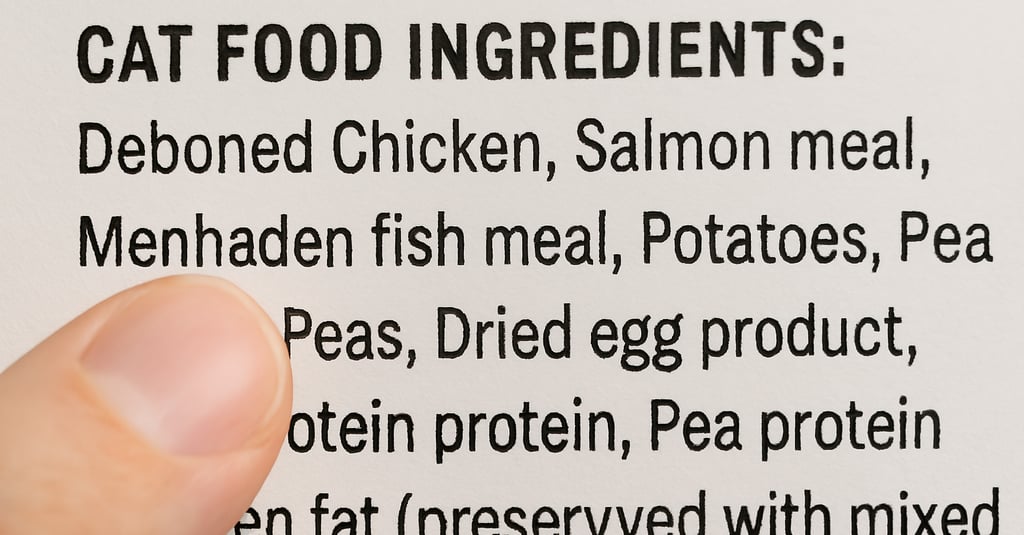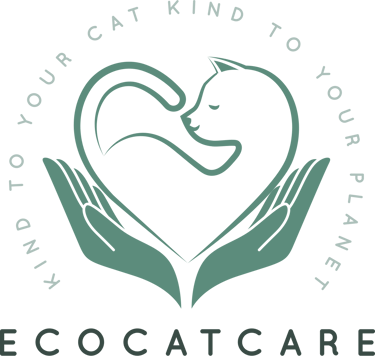Decoding Cat Food Labels: What "Natural" and "Organic" Really Mean (And What to Look For)
NOURISHING YOUR CAT & THE PLANET


Navigating the pet food aisle can feel like deciphering a complex code. Buzzwords like "natural" and "organic" are splashed across packaging, promising the best for our feline companions. But what do these terms truly signify when it comes to cat food? Understanding the nuances of pet food labeling is crucial for making informed decisions that support both your cat's health and your sustainable living goals. This post will help you cut through the marketing jargon and identify what to genuinely look for on a cat food label.
The Allure of "Natural"
The term "natural" on pet food packaging often evokes images of wholesome ingredients, minimally processed, and free from artificial additives. According to the Association of American Feed Control Officials (AAFCO), a non-governmental organization that sets standards for animal feeds and pet foods in the United States, "natural" means a feed or ingredient derived solely from plant, animal, or mined sources. It should not have been subjected to a chemically synthetic process and should not contain any additives or processing aids that are chemically synthetic. However, this definition allows for ingredients to undergo common processes like grinding, cooking, and extracting. Vitamins, minerals, and other trace nutrients can be added and are often synthetic, yet the product can still be labeled "natural" as long as these additions are disclosed with a disclaimer like "Natural with added vitamins, minerals, and trace nutrients."
What "natural" doesn't guarantee is the quality of the source ingredients, the nutritional adequacy of the food, or the environmental impact of its production. A "natural" cat food could still contain by-products of unspecified quality or ingredients sourced from unsustainable farming practices. Therefore, while "natural" can be a good starting point, it's essential to look deeper into the ingredient list and the manufacturer's sourcing practices.
Understanding "Organic"
"Organic" is a more regulated term than "natural." For a cat food to be labeled "organic" in the United States, it must comply with the standards set by the U.S. Department of Agriculture's (USDA) National Organic Program (NOP). These standards are rigorous and cover various aspects of food production, including soil quality, animal raising practices, pest and weed control, and the use of additives.
Here's what different organic labels mean:
"100% Organic": All ingredients and processing aids must be certified organic. The USDA organic seal can be displayed.
"Organic": At least 95% of the ingredients (excluding salt and water) must be certified organic. The remaining 5% must be non-GMO and on an approved list of non-organic ingredients. The USDA organic seal can be displayed.
"Made with Organic Ingredients": At least 70% of the ingredients must be certified organic. The USDA organic seal cannot be displayed, but the certifying agent's seal may be used. The specific organic ingredients can be listed on the packaging.
Choosing organic cat food means you are opting for a product made without synthetic pesticides, herbicides, genetically modified organisms (GMOs), irradiation, or synthetic fertilizers. For animal-derived ingredients, organic certification ensures that the animals were raised without routine use of antibiotics or growth hormones and had access to the outdoors. This often translates to a higher quality product with a lower environmental footprint compared to conventionally produced pet foods.
Beyond the Buzzwords: What to Actually Look For
While "natural" and "organic" provide some information, a truly discerning pet parent needs to scrutinize the label further. Here are key elements to focus on:
The Ingredient List: Ingredients are listed by weight, with the heaviest first. Look for high-quality, named protein sources (e.g., "chicken," "turkey," "salmon") as the first few ingredients, rather than vague terms like "meat meal" or "poultry by-product meal" (unless the specific animal source is named, like "chicken by-product meal"). Cats are obligate carnivores, so a meat-rich diet is essential.
Guaranteed Analysis: This section provides the minimum percentages of crude protein and crude fat, and the maximum percentages of crude fiber and moisture. Compare these values to your cat's specific dietary needs, which can vary based on age, activity level, and health conditions.
AAFCO Nutritional Adequacy Statement: This statement indicates whether the food is formulated to meet the nutritional levels established by AAFCO for a specific life stage (e.g., "growth and reproduction" for kittens and pregnant/nursing queens, or "adult maintenance" for adult cats). Look for foods that have undergone AAFCO feeding trials for their specific life stage claim, as this provides a higher level of assurance than formulation alone.
Specific Protein and Fat Sources: Knowing the exact type of meat (e.g., deboned chicken, lamb meal) and fat (e.g., chicken fat, sunflower oil) helps assess the quality and potential allergens.
Carbohydrate Sources: Cats have limited ability to digest carbohydrates. Look for foods with limited and digestible carbohydrate sources like sweet potatoes or peas, rather than excessive fillers like corn, wheat, or soy, especially if listed high on the ingredient list.
Avoidance of Artificial Additives: Steer clear of artificial colors, flavors, and preservatives like BHA, BHT, and ethoxyquin. Natural preservatives include tocopherols (vitamin E), citric acid, and rosemary extract.
Manufacturer Transparency and Sourcing: Reputable brands are often transparent about where their ingredients come from and their manufacturing processes. Check their website or contact them for more information. Look for certifications beyond organic, such as those related to sustainable fishing (e.g., MSC blue tick) or humane animal treatment.
Making Sustainable Choices
Choosing sustainable cat food goes hand-in-hand with understanding labels. Organic foods, by their nature, tend to be more sustainable due to restrictions on synthetic inputs and requirements for better land management. Additionally, consider:
Protein Sources: Some proteins have a lower environmental impact than others. Poultry, for instance, generally has a smaller carbon footprint than beef.
Packaging: Look for brands using recyclable or minimalist packaging.
Local Sourcing: While not always evident on the label, brands that source ingredients locally can reduce transportation emissions.
Decoding cat food labels is an essential skill for any eco-conscious cat owner. By looking beyond simple marketing terms and understanding the ingredient list, guaranteed analysis, and certifications, you can make choices that are not only healthier for your cat but also kinder to the planet. Your diligence ensures your feline friend thrives on a diet that is both nourishing and responsibly produced.
CTA Teaser: Want a deep dive into choosing truly sustainable and healthy cat food, including brand recommendations and detailed ingredient analysis? Our Eco-Conscious Cat Feeder guide has all the answers to help you nourish your cat and the planet! Get the full scoop and transform your cat's mealtimes.




Sustainable Cat Care
At EcoCatCare, we provide resources that help cat parents discover how sustainable choices can create healthier, happier lives for their feline companions while contributing to a healthier planet.
EcoCatCare © 2025. All rights reserved
